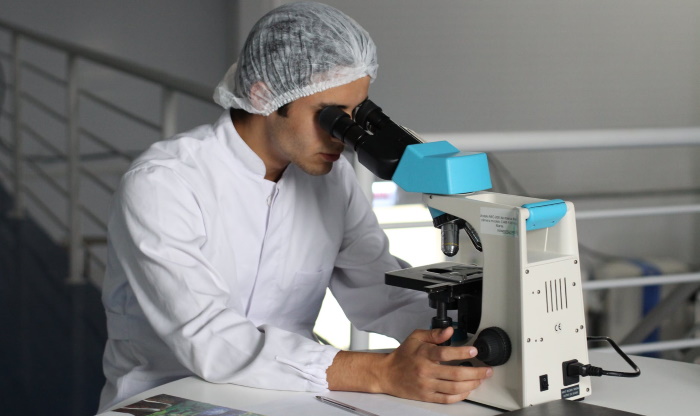Scientists have “trained” some microorganisms to poop terpenes, including many of the most common terpenes normally found in cannabis. These microorganisms include bacteria, fungi, algae, and even cutworm larvae, but E. coli is the champion of biotransformation, with scientists engineering these common bacteria to produce several different monoterpenes and sesquiterpenes as “waste” products. However, although this may sound weird and surprising to some, this isn’t a new technology; researchers have been working on these projects for decades.
When some microorganisms are fed a specific substance as food, the process of digestion or biotransformation results in the organism pooping out a totally different substance. In many cases, the food taken in becomes terpenes on the way out. Researchers have taken advantage of this shit, and have even begun engineering certain microorganisms to poop some of the most useful and difficult-to-produce terpenes.
E. coli bacteria is the standard that scientists work with when they’re looking for a microorganism to figuratively crap gold. These bacteria have been engineered to eat carbon and poop sabinene[1], a Top 30 terpene in cannabis. Other researchers produced nootkatone – a valuable and difficult-to-produce aroma molecule – from the biotransformation of valencene by E. coli[2]. Researchers in China engineered E. coli to consume glucose and then poop out geraniol[3], while other work has shown that E. coli can be metabolically engineered to produce farnesene[4], and myrcene[5], and, if fed acetic acid, the bacteria can produce beta-caryophyllene[6] – a dietary cannabinoid. Fascinatingly, E. coli has also been engineered to inversely produce geraniol from geranyl acetate, and geranyl acetate from geraniol[7] – both important terpenes in cannabis.
Other work training bacteria to poop valuable compounds includes producing farnesene photosynthetically from the cyanobacterium Anabaena sp., using only CO2, mineralized water, and light[8].
Fungi has also been the subject of this seemingly mad-scientist work, with Corynespora cassiicola, a species of sac fungus, being engineered to produce valuable linalool oxides after being fed pure linalool[9]. Brewer’s yeast (S. cerevisiae) – already in use for centuries to produce beer – has been engineered to produce the monoterpene ester geranyl acetate via the biotransformation of various media[10], while other scientists have built cell factories where S. cerevisiae produces nerolidol[11] – a Top 10 terpene in cannabis. Botrytis cinereal – a common and pervasive fungal pathogen of cannabis – has been engineered to poop geraniol as a gasoline alternative[12], and, in a twist of function, two Mucor fungi species have been engineered to consume the terpene valencene, and in turn produce nootkatone[13].
Moving beyond classic microorganisms, scientists have produced several new variations of fenchol – a Top 15 terpene in cannabis – by feeding the pure compound to cutworm larvae[14] (Spodoptera litura).
While this work may seem novel and interesting, it’s likely that this could be the beginning of the end of sourcing terpenes from trees, herbs, and other plants, as many of these processes are inefficient and destructive to the environment. One day soon, the bulk of our need for important compounds may be filled with products that were engineered for us in factories staffed by bacteria or fungi. In other words, we’re not too far away from being full of shit.
[1] Haibo Zhang, Qiang Liu, Yujin Cao, Xinjun Feng, Yanning Zheng, Huibin Zou, Hui Liu, Jianming Yang, Mo Xian. Microbial production of sabinene—a new terpene-based precursor of advanced biofuel Microbial Cell Factories volume 13, Article number: 20 (2014)
[2] Zelena K, Krings U, Berger RG. Functional expression of a valencene dioxygenase from Pleurotus sapidus in E. coli. Bioresour Technol. 2012 Mar;108:231-9
[3] Wei Liu, Xin Xu, Rubing Zhang, Tao Cheng, Yujin Cao, Xiaoxiao Li, Jiantao Guo, Huizhou Liu & Mo Xian Engineering Escherichia coli for high-yield geraniol production with biotransformation of geranyl acetate to geraniol under fed-batch culture Biotechnology for Biofuels volume 9, Article number: 58 (2016)
[4] Wang, Chonglong, Sang-Hwal Yoon, Hui-Jeong Jang, Young-Ryun Chung, Jae-Yean Kim, Eui-Sung Choi, and Seon-Won Kim. “Metabolic engineering of Escherichia coli for α-farnesene production.” Metabolic Engineering 13.6 (2011): 648-655
[5] Kim EM, Eom JH1 Um Y, Kim Y, Woo HM. Microbial Synthesis of Myrcene by Metabolically Engineered Escherichia coli. J Agric Food Chem. 2015 May 13;63(18):4606-12. doi: 10.1021/acs.jafc.5b01334
[6] Biosynthesis of β-caryophyllene, a novel terpene-based high-density biofuel precursor, using engineered Escherichia coli JianmingYang, Zhengfeng Li, Lizhong Guo, Juan Du, Hyeun-Jong Bae Renewable Energy Volume 99, December 2016, Pages 216-223
[7] Liu, W., Xu, X., Zhang, R. et al. Engineering Escherichia coli for high-yield geraniol production with biotransformation of geranyl acetate to geraniol under fed-batch culture. Biotechnol Biofuels 9, 58 (2016) doi:10.1186/s13068-016-0466-5
[8] Charles Halfmann, Liping Gu, William Gibbons, Ruanbao Zhou. Genetically engineering cyanobacteria to convert CO2, water, and light into the long-chain hydrocarbon farnesene. Applied Microbiology and Biotechnology December 2014, Volume 98, Issue 23, pp 9869–9877
[9] Bormann, Sebastian, Maria Etschmann, Marco-Antonio Mirata, and Jens Schrader. “Integrated bioprocess for the stereospecific production of linalool oxides from linalool with Corynespora cassiicola DSM 62475.” Journal of Industrial Microbiology Biotechnology 39.12 (2012): 1761-1769
[10] Wu, T., Li, S., Zhang, B. et al. Engineering Saccharomyces cerevisiae for the production of the valuable monoterpene ester geranyl acetate. Microb Cell Fact 17, 85 (2018)
[11] Construction of cell factories for high production of nerolidol in Saccharomyces cerevisiae (brewer’s yeast) Zhang LL, Ma XL, Wang D, Yu P, Huang LQ, Zhang XL, Dai ZB. Zhongguo Zhong Yao Za Zhi. 2017 Aug;42(15):2962-2968. doi: 10.19540/j.cnki.cjcmm.20170714.002
[12] G. Bock, I. Benda, P. Schreier. Microbial transformation of geraniol and nerol by Botrytis cinerea Applied Microbiology and Biotechnology January 1988, Volume 27, Issue 4, pp 351–357
[13] Furusawa M, Hashimoto T, Noma Y, Asakawa Y. Highly efficient production of nootkatone, the grapefruit aroma from valencene, by biotransformation. Chem Pharm Bull (Tokyo). 2005 Nov;53(11):1513-4
[14] Miyazawa, Mitsuo, and Yohei Miyamoto. “Biotransformation of (+)-(1 R ,2 S )-fenchol by the larvae of common cutworm ( Spodoptera litura ).” Tetrahedron 60.13 (2004): 3091-3096
